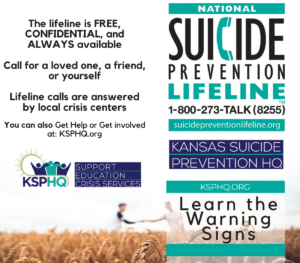
Learn the Warning Signs of suicide
These warning signs may mean that someone is at risk of suicide. Risk is greater if a behavior is new or has increased and seems related to a painful event or loss
Immediate Warning Signs:
- Talking or writing about suicide
- Has a plan
- Expressing hopelessness about the future
- Making preparations for suicide (giving away belongings, writing a suicide note, looking for means to attempt suicide)
Other Warning Signs:
- Unusual fatigue/more energy
- Lack of concentration
- Changes in hygiene
- Increasing use of alcohol, drugs or other risky behavior
- Increasingly agitated, anxious, sad, angry
- Withdrawing from social activities
- Spending more time alone or isolating
- Experience of loss
If you think someone you know might be suicidal, learn how to help them on our Support Others page
Training and Presentations for Community Members
Introduction to Suicide Prevention
An overview of relevant suicide statistics to help the presentation audience identify the scope of the problem of suicide and possible
interventions for suicide prevention in their sector. The presentation includes a review of the warning signs of suicide and a review of the theory explaining how some may come to consider suicide.
Suicide Talk
There are steps we can all take to make our homes safer for our loved ones. This session will discuss steps and plans that we can all take to keep youth and those living with suicidal thoughts safe at home. Particular attention will be paid to firearm safety resources.
ASIST (Applied Suicide Intervention Skills Training)
This is a two-day workshop for learning suicide intervention skills. The focus is on learning to identify suicide risks and developing a plan with the person at risk to stay safe for now. Participants are taught to identify possible warning signs for suicide including changes in behavior such as isolation, withdrawal, discussing suicide, increase in substance use, aggressiveness, and feelings of hopelessness or pain. Participants are then taught to identify a plan that will keep the person safe which often includes helping the person seek longer-term support or
Suicide Safety at Home
There are steps we can all take to make our homes safer for our loved ones. This session will discuss steps and plans that we can all take to keep youth and those living with suicidal thoughts safe at home. Particular attention will be paid to firearm safety resources.
QPR (Question, Persuade, Refer)
The CPR for suicide risk. At the end of this session, participants will be competent in identifying someone at risk of suicide and helping to connect them to their next resource.
C.A.L.M. (Counseling Access to Lethal Means)
90-120 minute training for parents or counselors that focuses on learning the skills necessary to restrict access to lethal means like firearms and abusive substances like pain medications, opioids, and over-the-counter medications. The training includes case studies and a safety plan for these substances.
Contact us or sign up for the newsletter to find a training near you.

